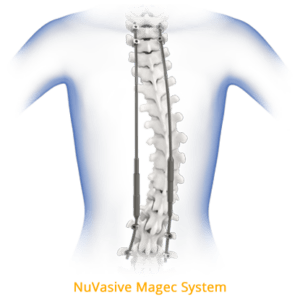 Do you have a child with scoliosis—an abnormal curvature of the spine? If so, you may be familiar with the Nuvasive MAGEC System, which may be used to treat the condition. Unfortunately, recent studies have suggested it may be defective, so it’s best to proceed with caution.
Do you have a child with scoliosis—an abnormal curvature of the spine? If so, you may be familiar with the Nuvasive MAGEC System, which may be used to treat the condition. Unfortunately, recent studies have suggested it may be defective, so it’s best to proceed with caution.
What Is Scoliosis?
Scoliosis affects about 100,000 children each year, according to the Children’s Hospital of Philadelphia. The condition causes the spine to curve sideways, which can result in symptoms like leaning to the right or left, difficulty walking, or having shoulders or hips that look uneven.
Sometimes the curve will straighten itself out as a child grows, but other times it simply gets worse. Without treatment, it can lead to disabling deformities, including those that cause lung and breathing problems, as well as chronic back pain.
Traditional treatment involves implanting one or two growing rods under the skin and attaching them to the spine above and below the curve. The rods help guide the spine into a correct position as the child grows, but they must be surgically lengthened about every six months.
What Is the Nuvasive MAGEC System?
The FDA approved the Nuvasive MAGEC System for early-onset scoliosis in September 2014, approving a later, updated version in 2017.
The system consists of a titanium adjustable growing rod that is surgically implanted and secured to the spine. It’s very similar to the rods used in traditional scoliosis treatments, with one exception: It can be lengthened from outside the body.
The implanted rods include magnets. During a simple office visit, the doctor holds the remote controller, which comes with the system, over the child’s spine. Magnets within the controller cause the magnet in the rods to rotate, which lengthens or shortens them as determined by the doctor.
In this way, the doctor can lengthen the rods as the child grows until the spine has sufficiently straightened and the rods can be removed.
What Can Go Wrong with the Nuvasive MAGEC System?
The idea behind the Nuvasive MAGEC System was a good one. Saving a child from repeated operations helps reduce the risks associated with surgical treatments, plus limits the stress and anxiety the child and his or her family have to endure.
Unfortunately, there have been reports of problems with the system. In a 2017 study, for instance, researchers examined five patients who had to have their MAGEC rods removed. There were nine rods total taken out of the backs of the patients, and three of the nine were found to have a fractured pin. All showed evidence of surface degradation and corrosion. The researchers warned surgeons that if the rods could not be lengthened during an office visit, it could be because of corrosion.
In a later 2018 study, researchers analyzed 34 MAGEC rods taken from 18 children. They found titanium wear debris inside all of them, with 91 percent showing measurable wear of the extending bar toward the magnet end. They also found substantial damage to the radial bearing in about three-quarters of the rods, and in 44 percent of them, the drive pin was fractured.
Meanwhile, reports of problems with the device have suggested the rods are prone to breakage, bending, loosening, and failing to lengthen as they’re supposed to. If you or a loved one has experienced these or other problems with MAGEC rods, you may be able to recover damages in a Nuvasive MAGEC System lawsuit.


